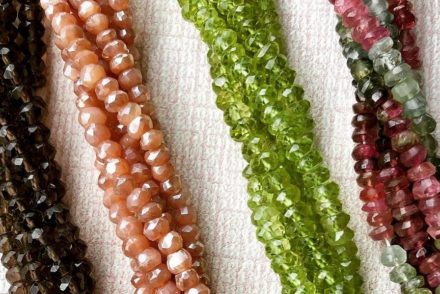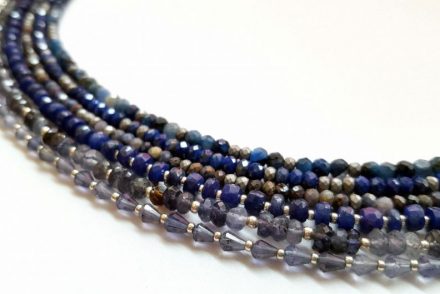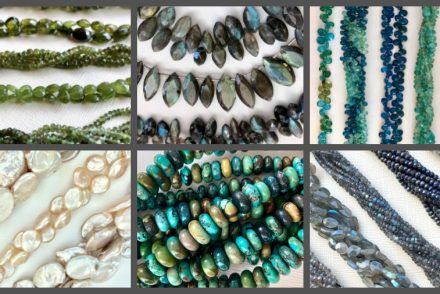If you’ve been to our bead shows,you know that most of our strands of beads are marked with “(K)” — and that we discount the price marked. From some notes provided by our owner Russ, here’s some background on “keystone pricing”:
The question of how and why we mark our beads’ price tags comes up from time to time. Russ has written about this “keystone pricing” in several forums, because it is confusing to people outside the mainstream jewelry industry. Why do we put a “K” on the price label and tell you you’re “really saving” a whole lot off of what’s marked? It’s a good topic for blogging!
The “real savings” at our shows is:
- The 15% extra discount off our catalog prices.
- The opportunity to hand-select the strands that meet your needs better than what we might select for you.
- The special purchase and cash and carry goods that we buy in smaller than catalog quantities to give you a much larger selection than you can find in our catalog.
#2 and #3 are self-explanatory, so let’s focus on #1. If you look at your invoice from one of our bead shows, you’ll see that the stranded goods and the net-price bagged goods were totaled separately. One column is marked “Strands (marked at retail)” while the other column is “Regular wholesale priced goods.” In the Strands column you should see 3 rows marked:
- “As per tape:”
- “-50% to Wholesale”
- “-15% Sale price:” <– this is the price you paid for your strands
Does that make sense? Read on for some background on our use of “Keystone pricing.”
Rings & Things has been selling to stores for a long time. We started with a line of filigree and bead earrings in the 1970’s. We sold these prepriced to boutiques, department stores and drug stores. Russ Nobbs, owner and founder, used to sell Southwestern and Native American jewelry to gift shops and tourist stores around the National parks in Montana, Idaho and Wyoming.
We had our jewelry marked with what is known in the trade as “Keystone Pricing”, that is, the goods were marked at suggested retail and the store paid 1/2 of the marked price. To indicate this we put a (K) next
to the price. Assuming the store took the typical 2X markup they did not have to reprice the goods before putting out for sale. (These days many stores require a longer markup. Fine jewelry suppliers often
provide goods prepriced with “triple keystone” pricing where the cost is 1/3 of the selling price. This is “3K” or “Triple Key” pricing.)
When we operated retail stores as well as our wholesale business the selling price to retail customers was the marked price while wholesale customers buying for resale paid “Keystone” or 1/2 of the retail price. Rings & Things continues to mark most stranded goods (i.e. gemstones, beads and pearls) with the suggested retail price and a (K) to indicate this is keystone pricing. This allows our customers to sell whole strands at the marked price and double their cost.
At our shows and in our showroom we announce that the goods are marked at retail and that wholesale is 1/2 of the marked retail price. Our wholesale catalog is priced at this same wholesale price. At most shows we give an extra 15% off the wholesale price.
This is not an attempt to control the selling price or suggest that the “regular” price is higher that it is marked. It’s simply a traditional way of marking pre-priced goods that has been used in the jewelry industry for more than 50 years.
Want to learn more? A Google search for origin of keystone pricing gives several hits including http://retail.about.com/od/glossary/g/keystone.htm
Can we answer any more questions about keystone bead pricing? Just ask in a comment below!






4 Comments
Thanks for the information! I am so sorry I missed the the Durham show. I’ll catch up with you guys the next go around
Aww, we’re sorry too, Tish. We’ll demonstrate this whole (K) thing, next show 🙂
So where does the name “keystone” come from for this purpose
– Hmm, interesting question, oldguy. I found this from Carol S. at the Wordcraft forums:
“The term keystone, meaning that 50% of the stated price should be considered to be the wholesale price, comes from the jewelry trade. It was originated in 1896 by Keystone magazine, a predecessor of Jewelers’ Circular-Keystone (JCK), after subscribers had complained about the showing of dealer costs in a publication that customers might see on jewelers’ counters.
The name of the magazine, Keystone, probably comes from the keystone cut, a fancy diamond cut whose outline is that of a keystone. (A keystone is the central, wedge-shaped stone at the top of an arch that locks the arch together.)”